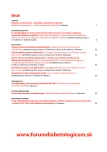What does the adoption of new international guidelines mean for screening and diagnosis of gestational diabetes mellitus?
Authors:
Kateřina Anderlová 1,2; Hana Krejčí 1,2; Martin Haluzík 1
Authors‘ workplace:
III. interní klinika 1. LF UK a VFN Praha
1; Gynekologicko-porodnická klinika 1. LF UK a VFN Praha
2
Published in:
Forum Diab 2014; 3(2): 67-73
Category:
Review
Overview
Gestational diabetes mellitus (GDM) is a disorder of glucose metabolism occurring in pregnancy which spontaneously disappears after delivery. However, it often occurs in other pregnancy or latter during life as diabetes mellitus type 2. The incidence of gestational diabetes increases worldwide similarly as incidence of diabetes mellitus type 2. Although, older data in Czech sources have shown prevalence of GDM in 3–4% pregnancies, currently, the prevalence is twofold higher using the same diagnostic criteria. Screening and diagnostic criteria are not internationally unified. In 2010, the International Association of Diabetes and Pregnancy Study Group – IADPSG published new guidelines for diagnosis of GDM based on results of international multicenter trial HAPO (Hyperglycemia and Adverse Pregnancy Outcomes). HAPO study is the first study which has observed the effect of mild hyperglycemia on development of gestational and perinatal complications in big cohort of pregnant women. IADPSG criteria have been adopted by many countries and by WHO as well. In April 2014, the IADPSG criteria were adopted by Czech Diabetes Society of the Czech Medical Association of Jan Evangelista Purkyne. Currently, ongoing discussion is under way among profesional societies of gynecologists and biochemists for establishment of unified algorithm in GDM diagnosis. In the article we show our data from retrospective analysis of oral glucose tolerance test which was performed on pregnant women in Czech Republic. The results reveal that the adoption of new guidelines for GDM will further increase the incidence of GDM (due to lower threshold for fasting glucose) which will demand changes in management of pregnant women with GDM.
Key words:
GDM – gestational diabetes – oGTT – oral glucose tolerant test – study Hyperglycemia and adverse pregnancy outcomes (HAPO)
Sources
1. World Health Organisation. Definition and diagnosis of diabetes mellitus and intermediate hyperglycemia: report of a WHO/IDF consultation. World Health Organisation: Geneva 2006. ISBN 92–4-159493–4.
2. King HM, Rewers M (WHO Ad Hoc Diabetes Reporting Group). Global estimates for prevalence of diabetes mellitus and impaired glucose tolerance in adults. Diabetes Care 1993; 16(1): 157–177.
3. Metzger BE, Lowe LP, Dyer AR et al (HAPO Study Cooperative Research Group). Hyperglycemia and adverse pregnancy outcomes. N Engl J Med, 2008, 358(19): 1991–2002.
4. Hillier TA, Pedula KL, Schmidt MM et al. Childhood obesity and metabolic imprinting. Diabetes Care 2007; 30(9): 2287–2292.
5. Owen LA, O´Sullivan EP, Kirwan B et al. ATLANTIC DIP: the impact of obesity on pregnancy outcome in glucose-tolerant women. Diabetes Care 2010; 33(3): 577–579.
6. Negrato CA, Gomes MB. Historical facts of screening and diagnosing diabetes in pregnancy. Diabetol Metabc Syndr 2013; 5(1): 22. Dostupné z DOI: <http://doi: 10.1186/1758–5996–5-22>.
7. O‘Sullivan JB, Mahan CM. Criteria for oral glucose tolerance test in pregnancy. Diabetes 1964; 13(3): 278–285.
8. World Health Organisation. Diabetes Mellitus: Report of WHO Study Group. World Health Organization: Geneva 1985. ISBN 92–4-120844–9.
9. Carpenter MW, Coustan DR. Criteria for screening tests for gestational diabetes. Am J Obst Gynecol 1982; 144(7): 768–773.
10. Metzger BE, Gabbe SG, Persson B et al (International Association of Diabetes and Pregnancy Study Groups). International association of diabetes and pregnancy study groups recommendations on the diagnosis and classification of hyperglycemia in pregnancy. Diabetes Care 2010; 33(3): 676–682.
11. World Health Organisation. Diagnostic criteria and classification of hyperglycaemia first detected in pregnancy. Health Organization: Geneva 2013. Dostupné z APPS: <http://apps.who.int/iris/bitstream/10665/85975/1/WHO_NMH_MND_13.2_eng.pdf>.
12. Andělová K. Doporučený postup provádění screeningu poruch glukózové tolerance v graviditě. Česká gynekologie 20013; 78(Suppl 1): 10.
13. Česká diabetologická společnost. Diabetes mellitus – laboratorní diagnostika a sledování stavu pacientů DMEV 2012; 15(1): 51–58.
14. Česká diabetologická společnost. Standardy péče o diabetes mellitus v těhotenství. DMEV 2007; 10(4): 229–231.
15. Česká diabetologická společnost ČLS JEP. Doporučený postup péče o diabetes mellitus v těhotenství 2014. Dostupné z WWW: <http://www.diab.cz/dokumenty/DP_DM_tehotenstvi_CDS_2014.pdf>.
16. Kanderková K, Schniererová D. Diabetes mellitus – epidemiológia, etiopatogenéza, klasifikácia, klinika, diagnostika. Dostupné z WWW: <http://www.medinfo.sk/?s=heslo&id=755>.
17. Anderlová K, Krejčí H, Klusáčková P et al. Alarmující výskyt gestačního diabetes mellitus při použití stávajících i nových mezinárodních diagnostických kritérií. Česká gynekologie 2014; přijato k tisku.
18. Franeková J, Jabor A. Gestační diabetes mellitus: analýza 2 043 výsledků oGTT – je čas na změnu? Klin Biochem Metab 2010; 18(39): 30–37.
19. Česká diabetologická společnost ČLS JEP. Diabetes a těhotenství. Dostupné z WWW: <http://www.diabetesatehotenstvi.cz/>.
Labels
Diabetology Endocrinology Internal medicineArticle was published in
Forum Diabetologicum

2014 Issue 2
Most read in this issue
- What does the adoption of new international guidelines mean for screening and diagnosis of gestational diabetes mellitus?
- Care of infant of diabetic mother
- Management of a pregnant woman with diabetes
- Obstetrician care of diabetic women type 1 and 2
